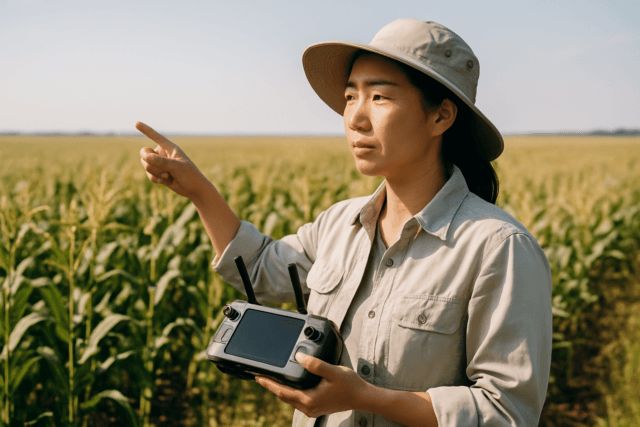The drone industry is taking off, and with it comes a soaring demand for skilled professionals who can make sense of the data these aerial vehicles collect. If you’re interested in a career that combines technology, data analysis, and a bit of adventure, then a drone data analyst job in the UK might be the perfect fit. This article will explore the ins and outs of this exciting field, covering everything from job responsibilities and required skills to salary expectations and career prospects.
What Does a Drone Data Analyst Do?
A drone data analyst is responsible for processing, analyzing, and interpreting data collected by drones. This data can include aerial imagery, video footage, thermal imagery, LiDAR data, and other sensor readings. The analyst transforms this raw data into actionable insights that can be used across a variety of industries.
Here’s a breakdown of the key responsibilities of a drone data analyst:
- Data Extraction and Preprocessing: Extracting data from various sensors mounted on drones and preparing it for analysis. This includes cleaning, filtering, and transforming the data to ensure its quality and accuracy.
- Image Processing and Analysis: Using specialized software to process aerial imagery, generate orthomosaics (geometrically corrected images), and create 2D and 3D models.
- Point Cloud Analysis: Analyzing LiDAR data to create detailed 3D models of the environment.
- Data Interpretation: Interpreting analyzed data to derive meaningful insights and identify patterns or anomalies.
- Report Generation and Visualization: Creating reports and visualizations (e.g., charts, graphs, maps) to communicate findings to clients and stakeholders.
- Data Management: Organizing and managing large datasets, ensuring data integrity and security.
- Collaboration: Working with drone pilots, surveyors, engineers, and other professionals to understand project requirements and deliver valuable insights.
- Staying Updated: Keeping abreast of the latest trends and technologies in drone data analysis, software, and industry applications.
- Automation: Automating data processing workflows to improve efficiency and accuracy.
Drone data analysts must also adhere to safety regulations and data extraction management protocols. The role also includes supporting the development and implementation of a drone data management plan.
Industries That Employ Drone Data Analysts
Drone data analysts are in demand across a wide range of industries, including:
- Agriculture: Monitoring crop health, assessing irrigation needs, and optimizing fertilizer application.
- Construction: Tracking construction progress, inspecting infrastructure, and creating 3D models of construction sites.
- Environmental Monitoring: Assessing environmental damage, monitoring wildlife populations, and mapping terrain.
- Surveying and Mapping: Creating accurate maps and models for land surveying, construction planning, and resource management.
- Energy: Inspecting power lines, pipelines, and wind turbines for damage or defects.
- Real Estate: Creating aerial photos and videos for property marketing.
- Public Safety: Assisting in search and rescue operations, assessing disaster damage, and monitoring crime scenes.
- Logistics and Delivery: Optimizing delivery routes and monitoring package delivery.
- Mining: Surveying mine sites, calculating stockpile volumes, and monitoring environmental compliance.
- Archaeology: Surveying sites and creating 3D models of artifacts.
Essential Skills for Drone Data Analysts
To succeed as a drone data analyst, you’ll need a combination of technical and soft skills. Here are some of the most important ones:
Technical Skills:
- Drone Piloting: While not always required, having drone piloting skills and a drone license (such as the UK’s A2 Certificate of Competency or General Visual Line of Sight Certificate (GVC)) can be a significant advantage.
- Data Analysis Software: Proficiency in industry-standard software such as:
- GIS Software: ArcGIS, QGIS
- Photogrammetry Software: Pix4Dmapper, DroneDeploy, Agisoft Metashape
- LiDAR Processing Software: LiDAR360
- Other Software: Global Mapper, DJI Terra, CloudCompare
- Data Visualization Tools: Experience with tools like Tableau, Power BI, or similar software to create compelling visuals.
- Programming Skills: Familiarity with programming languages like Python (especially libraries like NumPy and Pandas) for data manipulation and analysis.
- Remote Sensing: Knowledge of remote sensing principles and techniques for collecting and analyzing data from a distance.
- Geospatial Technologies: A strong understanding of geospatial concepts, coordinate systems, and mapping principles.
- 3D Modeling: Ability to create and manipulate 3D models from drone data.
- Machine Learning: Knowledge of machine learning algorithms and techniques for automated feature detection and classification.
Soft Skills:
- Analytical Skills: The ability to interpret complex data, identify patterns, and draw meaningful conclusions.
- Problem-Solving Skills: A knack for identifying and solving problems related to data quality, processing, and analysis.
- Communication Skills: Excellent written and verbal communication skills to effectively convey findings to clients and stakeholders.
- Attention to Detail: A meticulous approach to ensure data accuracy and quality.
- Project Management Skills: The ability to plan, organize, and manage drone data analysis projects effectively.
- Teamwork and Collaboration: The capacity to work effectively with drone pilots, surveyors, engineers, and other professionals.
- Adaptability: The flexibility to adapt to changing project requirements and learn new technologies.
- Critical Thinking: Applying logical reasoning to evaluate data and make informed decisions.
Education and Training
While there isn’t a specific “drone data analyst” degree, here are some educational paths that can lead to this career:
- Bachelor’s Degree: A bachelor’s degree in a related field such as:
- Geographic Information Science (GIS)
- Remote Sensing
- Surveying
- Environmental Science
- Computer Science
- Data Science
- Engineering
- Certifications: Consider obtaining certifications in drone operations, data analysis, or specific software platforms. Some relevant certifications include:
- Certified Professional in Advanced Drone Data Analysis
- GIS Professional (GISP)
- Software-specific certifications (e.g., ArcGIS, Pix4D)
- Short Courses and Workshops: Many institutions offer short courses and workshops on drone data analysis, image processing, and related topics.
- Online Courses: Platforms like Coursera, Udemy, and edX offer online courses in drone technology, data analysis, and GIS.
Salary Expectations in the UK
The salary for drone data analysts in the UK can vary depending on experience, location, industry, and the specific skills required for the job. However, here are some general guidelines:
- Entry-Level: £25,000 – £35,000 per year
- Mid-Level (2-5 years of experience): £40,000 – £60,000 per year
- Senior-Level (5+ years of experience): £60,000 – £75,000+ per year
According to some sources, drone data analysts in specialized fields like environmental science or precision agriculture can earn on the higher end of the scale, potentially reaching £65,000 annually.
Factors influencing salary include:
- Experience Level: Salaries rise with expertise and years of experience.
- Location: London, the South East, and the Midlands are leading regions for UAV jobs and may offer higher salaries.
- Specialization: Roles in UAV engineering, data analytics, and autonomous systems command higher pay.
- Industry Sector: Jobs in construction, logistics, and defense typically offer higher compensation.
- Certifications and Skills: GVC, A2 CofC, and expertise in software tools or hardware design boost earning potential.
Job Outlook and Career Prospects
The job outlook for drone data analysts is positive, with the drone industry expected to continue growing in the coming years. As more industries adopt drone technology, the demand for skilled data analysts will increase.
Here are some potential career paths for drone data analysts:
- Senior Data Analyst: Leading data analysis projects, developing innovative algorithms, and mentoring junior team members.
- GIS Specialist: Integrating drone data into existing GIS systems for spatial analysis and visualization.
- Project Manager: Managing drone-based projects from start to finish, ensuring that data is collected and analyzed effectively.
- Consultant: Providing expert advice to organizations on how to use drone technology and data analysis to improve their operations.
Tips for Landing a Drone Data Analyst Job
Here are some tips to help you land a drone data analyst job in the UK:
- Build a Strong Portfolio: Showcase your data analysis skills by creating a portfolio of projects that demonstrate your ability to process, analyze, and interpret drone data.
- Gain Relevant Experience: Look for internships or entry-level positions in related fields such as GIS, remote sensing, or surveying.
- Network with Industry Professionals: Attend drone industry events and connect with professionals on LinkedIn to learn about job opportunities and build relationships.
- Tailor Your Resume and Cover Letter: Customize your resume and cover letter to highlight the skills and experience that are most relevant to the specific job you’re applying for.
- Prepare for the Interview: Research the company and the role, and be prepared to answer technical questions about drone data analysis and related software.
Software and Tools Used by Drone Data Analysts
Drone data analysts use a variety of software and tools to process, analyze, and visualize drone data. Here are some of the most common ones:
- Pix4Dmapper: A leading photogrammetry software for creating orthomosaics, 3D models, and point clouds from drone imagery.
- DroneDeploy: A cloud-based platform for drone mapping and analytics, offering tools for flight planning, data processing, and collaboration.
- Agisoft Metashape: Another popular photogrammetry software known for its accuracy and versatility.
- ArcGIS: A powerful GIS software for spatial analysis, mapping, and data management.
- QGIS: A free and open-source GIS software that offers a wide range of features and capabilities.
- CloudCompare: A 3D point cloud processing software for visualizing, editing, and analyzing point cloud data.
- Global Mapper: A GIS software for mapping, surveying, and data conversion.
- LiDAR360: A software for processing and analyzing LiDAR data, creating 3D models, and extracting features.
- MATLAB: A programming language and environment for data analysis, algorithm development, and mathematical computation.
- Python: A versatile programming language with libraries like NumPy, Pandas, and scikit-learn for data analysis and machine learning.
- Tableau: A data visualization tool for creating interactive dashboards and reports.
- Airdata UAV: A platform used to manage and analyze drone flights.
The Future of Drone Data Analysis
The field of drone data analysis is constantly evolving, with new technologies and applications emerging all the time. Here are some trends to watch for in the future:
- Increased Automation: As machine learning and artificial intelligence become more sophisticated, more data analysis tasks will be automated, allowing analysts to focus on higher-level insights.
- Real-Time Data Processing: Advances in drone technology and data processing software will enable real-time data analysis, providing immediate feedback and insights.
- Integration with Other Technologies: Drone data will be increasingly integrated with other data sources, such as IoT sensors and satellite imagery, to provide a more comprehensive view of the world.
- New Applications: As drone technology becomes more accessible and affordable, new applications for drone data analysis will emerge in industries such as healthcare, insurance, and entertainment.
Conclusion
Drone data analyst jobs in the UK offer a unique opportunity to combine technical skills with a passion for innovation and problem-solving. With the drone industry poised for continued growth, now is an excellent time to pursue a career in this exciting field. By developing the right skills, gaining relevant experience, and staying up-to-date on the latest trends and technologies, you can position yourself for success in the world of drone data analysis. So, if you’re ready to take your career to new heights, consider becoming a drone data analyst and help shape the future of this rapidly evolving industry.





